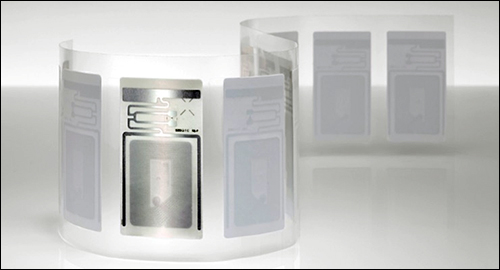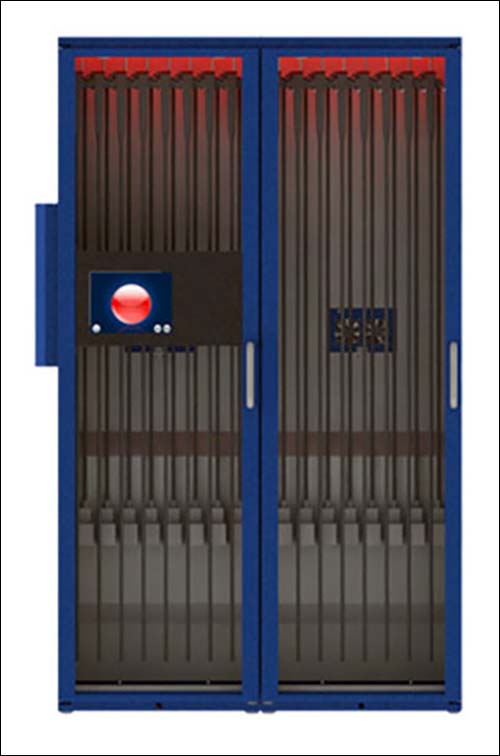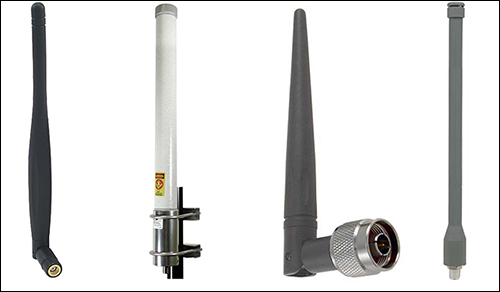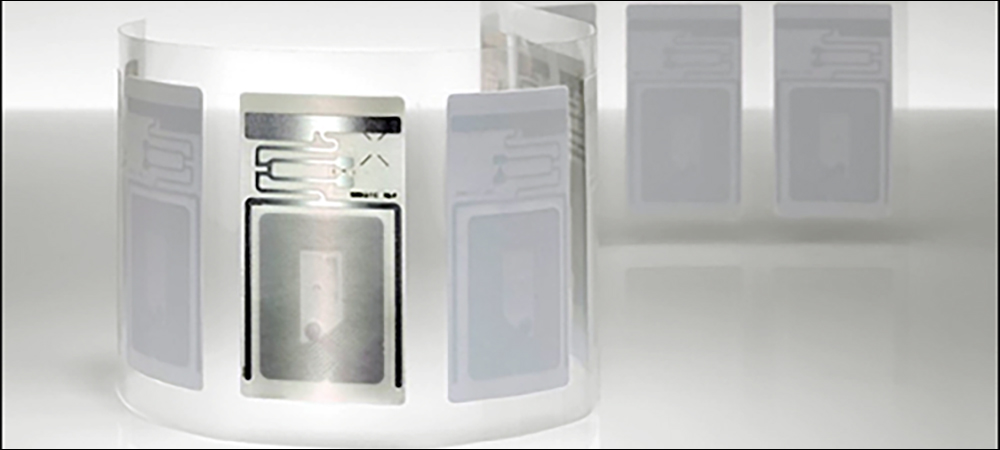Presented here are recent news announcements regarding the following organizations: Avery Dennison, PENTAX Medical, Mobile Aspects, ShowMeCables, Landis+Gyr, Vodafone Business, the Industrial Internet Consortium, and Plattform Industrie 4.0.
Avery Dennison Launches RFID-EAS Inlay for Retail
Avery Dennison has launched its AD-362r6-P inlay, which combines the item-level tracking and digital ID capabilities of a UHF RFID tag (making it suitable for retail apparel products and applications) with the loss-prevention functionality of an electronic article surveillance (EAS) tag. The inlay’s design incorporates both technologies in a single die-cut label. Each inlay is equipped with an IC that offers 96 or 128 bits of Electronic Product Code (EPC) memory and 64 or 32 bits of user memory. TID memory is 96 bits, with a 48-bit unique serial number.

The RFID-related features of the AD-362r6-P inlay are intended to offer retailers greater inventory accuracy and brand security, as well as the ability to improve the customer shopping experience by boosting convenience and utility. The inlay enables self-checkout while allowing EAS-based anti-theft functionality. When the inlay is scanned by an RFID reader during the checkout procedure, the EAS function can be deactivated automatically, eliminating the need for the manual detachment of the EAS tag.
“Our new dual-technology AD-362r6-P inlay is proof to our ability to listen and quickly respond to our retail customers who need to leverage RFID capabilities with their RF EAS infrastructure including gate readers installed at store exits to mitigate theft,” said Hal Hikita, Avery Dennison Intelligent Labels’ head of product line management, in a prepared statement. The inlay has been approved by Auburn University’s RFID Lab, meets the ARC performance and quality requirements, and is available now in high volumes.
PENTAX Medical, Mobile Aspects Sign RFID Product Distribution Agreement
PENTAX Medical, a provider of diagnostic and therapeutic endoscopy solutions, has announced a distribution agreement with Mobile Aspects for its iRIScope software and iRIScope cabinets product line. Under the terms of the agreement, PENTAX Medical will serve as a United States sales agent for these products.
 The flexible iRIScope endoscope tracking system utilizes barcode and RFID technologies to detect additions or removals of endoscopes without the need for manual human input, while identifying which device has been used on each patient. The system provides regulatory compliance, decreases the risk of cross-contamination and increases efficiencies, the company reports, by tracking endoscope usage. Mobile Aspects’ locking cabinets are built to meet endoscope storage guidelines via the use of HEPA filters, as well as positive pressure and optional channel drying. The cabinets function as a security system for the endoscopes.
The flexible iRIScope endoscope tracking system utilizes barcode and RFID technologies to detect additions or removals of endoscopes without the need for manual human input, while identifying which device has been used on each patient. The system provides regulatory compliance, decreases the risk of cross-contamination and increases efficiencies, the company reports, by tracking endoscope usage. Mobile Aspects’ locking cabinets are built to meet endoscope storage guidelines via the use of HEPA filters, as well as positive pressure and optional channel drying. The cabinets function as a security system for the endoscopes.
“Our commitment at PENTAX Medical is to provide our customers with solutions that help improve clinical outcomes and help efficiently manage healthcare costs while enhancing the patient experience,” said Gerald W. Bottero, PENTAX Medical’s global president, in a prepared statement. “We are delighted to partner with Mobile Aspects, an organization that echoes this devotion. The iRIScope system enables PENTAX Medical to provide a revolutionary endoscope safety and tracking solution to all hospitals and healthcare facilities in the U.S.”
“Mobile Aspects is proud to partner with PENTAX Medical to deliver the most comprehensive safety and endoscope management solution available,” added Suneil Mandava, Mobile Aspects’ president and CEO, in the prepared statement. “We are excited to bring the expertise from both teams to deliver the best solution of this type to PENTAX Medical’s large customer base. iRIScope is the single truly complete endoscope management system that will work in a facility or across a health system to drive patient safety, meet regulatory requirements, and provide data for further cost savings.”
ShowMeCables Releases Omnidirectional, Rubber Duck Antennas for IoT
ShowMeCables, a supplier of connectivity solutions, is offering L-com-brand omnidirectional and rubber duck antennas for Internet of Things (IoT) and wireless applications, as well as for amateur radio. The e-commerce brand specializes in in-stock IT, voice, video and data network cables and connectivity products. Its parent company, Infinite Electronics, offers components, assemblies and wired or wireless connectivity solutions for the aerospace, defense, industrial, government, consumer electronics, instrumentation, medical and telecommunications markets.
The omnidirectional antennas include 15 models that cover frequency bands ranging from 2.4 GHz to 5.8 GHz. The antennas boast gain from 2 dBi to 15 dBi and have a 360-degree horizontal beam width. They feature a fiberglass radome and an N-female connector, and they come with a heavy-duty mounting kit.
 The rubber duck antennas consist of 30 models with gain ranging from 0 dBi to 9 dBi. They cover a frequency band range of 860 MHz to 5.8 GHz and have a 360-degree horizontal beam width. These antennas feature a compact design as small as 1 inch in length, with a tilt and swivel design. They are suitable for multipoint and mobile applications, the company reports, improving signal range and quality in existing setups.
The rubber duck antennas consist of 30 models with gain ranging from 0 dBi to 9 dBi. They cover a frequency band range of 860 MHz to 5.8 GHz and have a 360-degree horizontal beam width. These antennas feature a compact design as small as 1 inch in length, with a tilt and swivel design. They are suitable for multipoint and mobile applications, the company reports, improving signal range and quality in existing setups.
“These new antennas are exciting additions to our product offering, as these Omni and rubber duck models boast compact size without compromising quality or effectiveness,” said Kevin Hietpas, ShowMeCables’ product line manager, in a prepared statement. “They are ideal, cost conscious solutions that exceed the average specifications of the market.”
Landis+Gyr, Vodafone Business Partner on Cellular IoT for Energy Management
Landis+Gyr, a provider of integrated energy-management solutions for the utility sector, and Vodafone Business, an Internet of Things (IoT) company with more than 100 million connections worldwide, have announced a strategic global agreement. Using Vodafone Business’s IoT services, Landis+Gyr’s utility customers can employ its Gridstream Connect solution to access multiple carrier networks without having to manage multiple subscription contracts. The global nature of the agreement provides access to more than 400 networks in 180 countries using a single subscriber identity profile.
The system is built on the IoT’s zero-touch capability. Landis+Gyr’s utility customers will benefit from improved deployment speed and management of cellular smart grid devices, the company reports. In addition, the partnership enables low-power wide-area (LPWA) technology capabilities, with the ability to transition to 5G networks wherever such networks are available. The solution comes with a long-term services contract. Landis+Gyr’s cellular solutions are designed to work with existing AMI networks, or to be deployed as primary networks to connect meters, sensors and IoT devices.
 “The partnership between Landis+Gyr and Vodafone Business, a global leader in IoT communication solutions, will allow us to further elevate our offerings to meet the unique needs of our customers today and in the future,” said Werner Lieberherr, Landis+Gyr’s CEO, in a prepared statement. “Together, we will be able to deliver longevity and quality of service to match utility asset lifecycles, creating the base for interactive smart grids with increasing intelligence embedded at the grid edge. This will enable our customers, energy consumers and entire communities to manage energy in a more informed way, making a positive impact on the environment.”
“The partnership between Landis+Gyr and Vodafone Business, a global leader in IoT communication solutions, will allow us to further elevate our offerings to meet the unique needs of our customers today and in the future,” said Werner Lieberherr, Landis+Gyr’s CEO, in a prepared statement. “Together, we will be able to deliver longevity and quality of service to match utility asset lifecycles, creating the base for interactive smart grids with increasing intelligence embedded at the grid edge. This will enable our customers, energy consumers and entire communities to manage energy in a more informed way, making a positive impact on the environment.”
“IoT is key to the digitalization of the utilities sector,” added Vinod Kumar, Vodafone Business’s CEO, in the prepared statement. “Connecting assets will help manage energy better and support the safe integration of renewable energy sources into power grids, helping to reduce carbon footprints. We believe advances in cellular networking technology will enable more and more companies to be not only more resilient and future-ready, but also more sustainable.”
Industrial Internet Consortium, Plattform Industrie 4.0 Offer Digital Twin White Paper
The Industrial Internet Consortium (IIC) and Plattform Industrie 4.0 have announced the publication of a white paper that explores digital twin technology concepts and their practical application. The white paper, titled “Digital Twin and Asset Administration Shell Concepts and Application,” provides definitions of digital twin technologies, standards and use cases. It also describes how Plattform Industrie 4.0’s Asset Administration Shell, an implementation of a digital twin for industrial applications, enables cross-company-interoperability. The white paper is part of a liaison agreement between the two organizations, designed to enable faster adoption of the IIoT through collaboration with industry partners.
“Digital twin is a key enabler and widely applicable for various Industrial IoT (IIoT) and Plattform Industry 4.0 use cases,” said Shi-Wan Lin, Yo-I Information Technology’s CTO and a co-chair of the IIC Technology Working Group, in a prepared statement. “Many organizations have implemented largely proprietary digital twins, resulting in an undesirable situation in which digital twin technologies and solutions are hard to share and reuse. We need a common conceptual understanding of the digital twin concept, information, and interaction models to enable interoperability for a wider application of digital twin technologies.”
The IIC developed a cross-industry general description and characterization of digital twin technology, including its technical aspects and requirements in information modeling, information population, information synchronization, APIs, connectivity, deployment, security and interoperability. In parallel, Plattform Industrie 4.0 focused on interoperability by building a consensus on concrete semantics based on use cases involving digital twins. The white paper compares the IIC’s findings with the technical capabilities of the Asset Administration Shell.
“The Asset Administration Shell is ready-to-implement and provides comprehensive support to the key requirements for digital twins as described and characterized by the IIC,” added Birgit Boss of Robert Bosch GmbH, Plattform Industrie 4.0’s chair of the Task Group on Asset Administration Shell, in the prepared statement. “Furthermore, the Asset Administration Shell can support digital twins beyond manufacturing use cases, although each industry must perform a thorough analysis to determine the applicability of the administration shell within its respective domain. Interoperability across industries is important for enabling new use cases and business models based on digital twins.”


